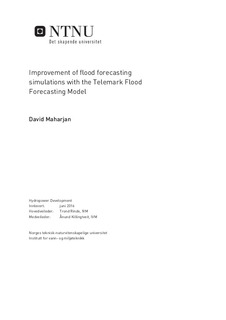| dc.description.abstract | Flood is the most common environmental hazard worldwide and can have an devastating consequences affecting the economy, environment, and people. The causes and nature of flood may be different, but it is important to control all of them. The typical cause of flood in Norway is a combination of heavy rainfall and snowmelt which results in an unexpected increase in runoff. This flash flood has been a serious threat to many communities in the lower reach of Skienselva river in Telemark county of Norway from past and control measures have been taken to control this.
Telemark flood forecasting model (FMTV) is the outcome seen as the controlling measure for the ever occurring flood problem in the region. FMTV consist of a hydrological model and a reservoir routing model for simulating inflow and provide operational decisions on water levels of the four reservoirs in the area. The operation of these reservoirs plays a critical role in the management of large flood. The model since its operation in 2003 has been functioning well until 2015 when two big flood events occurred when reservoirs were almost full.
After these floods in 2015, it was considered the necessity to improve flood forecasting simulation with the model. It was clear that the model introduces errors when simulating large flood events. Out of various possible possibilities that introduce errors, this study is focused on flood spill from intakes along headrace tunnels as these are not considered in the model. For this, data necessary to run the model were collected from different sources. Consistency and reliability of these data were studied.
The model was run for the historic flood events, small, medium and large flood events and checked how model simulated during these flood events for various years. The spill data were collected for reservoirs and added to the model for respective large flood events. In addition to this, capacities of brook intakes located in the tunnel on the way to hydropower plant were calculated. These missing values were added to the model and simulation was conducted for large flood events during various years.
In conclusion, this study has been successful in identifying a key issue related to the low performance of FMTV model during large flood events. The inclusion of flood spills is a major addition to improvement of flood forecasting simulation. Further improvement in the flood forecasting simulation can be achieved by modifying the prevailing scaling factor used to compute inflow from the local catchment of the reservoirs used in the flood computation. | |

